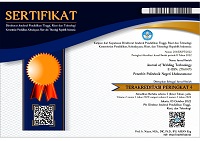The Effect of Weld Current and Weld Time on the Push Test, Nugget and Penetration Depth of Steel Plate SPFC590 with Weld T-Nut M10
Abstract
Keywords
Full Text:
PDFReferences
D. Prastya, M. Mustafa, and S. Sutrisno, “Pengaruh Variasi Welding Time pada Permukaan Lembaran Baja Tahan Karat SUS 304 yang Mengalami Pengelasan Resistansi Titik,” Prosiding Seminar Nasional Sains dan Teknologi Terapan, vol. 1, no. 1, pp. 403–408, 2019.
. Suwarto, Suparno, and A. Ashwin, “Pengaruh Variasi Kuat Arus dan Waktu Pengelasan Pada Proses Spotwelding Terhadap Kekuatan Tarik Dari Plat Mild Steel Tebal 1 Milimeter,” Seminar Nasional Inovasi dan Aplikasi Teknologi di Industri 2019, vol. 5, no 4 pp. 276–284, 2019.
. A. Fikri, K. Setiyadi, and Mohammad Mujirudin, “Pengaruh Kuat Arus Pengelasan Gmaw Terhadap Kedalaman Penetrasi Dan Kekerasan Baja St-37 Pada Daerah Heat Affected Zone,” Jurnal Konversi dan Manufacturing, vol. 7, no. 2, pp. 116–122, 2022.
. S. Muddin, “Pengaruh Hasil Pengelasan Terhadap Kekuatan Dan Kekerasan,” ILTEK Journal Teknology, vol. 11, no. 02, pp. 1658–1663, 2016.
. S. Wahyu Firmansyah, Heru Suryanto, “Pengaruh Variasi Waktu Penekanan Pengelasan Titik Mikro Pada Sambungan Dissimilar Baja Tahan Karat Aisi 304 Dengan Baja Karbon Rendah St 41,” Jurnal Teknik Mesin, no. 2, pp. 2–9, 2016.
. L. Habib, R. S. Ahmed, B. Habib, and M. Guagliano, “Experimental Study of Spot Weld Parameters in Resistance Spot Welding Process,” Mechanics and Mechanical Engineering vol. 22, no. 1, pp. 179–186, 2018.
. R. Rasyid and N. S. Drastiawati, “Pengaruh waktu pengelasan titik terhadap kekerasan, kekuatan geser, dan diameter nugget pada baja SPCEN 1,6 mm,” Otopro, vol. 16, no. 1, p. 1 - 6, 2020.
. R. Kartikasari, “Pengaruh variasi waktu penekanan pengelasan titik terhadap kekuatan tarik, kekerasan, dan struktur mikro pada sambungan dissimilar baja tahan karat AISI 304 dengan baja karbon rendah ST41,” Jurnal Teknik Mesin, vol. 24, no. 2, pp. 1 – 8, 2016.
. A. E. Purkuncoro and A. Taufik, “Analisa Pengaruh Variasi Pressing Welding Time Terhadap Karakteristik Sifat Mekanik Dan Sifat Fisis Pada Proses Resistance Spot Welding (Rsw) Material Plat Galvanis,” Jurnal Flywheel, vol. 11, no. 1, pp. 27–32, 2020.
. M. Nufal Akbar, Djoko Andrijono, “Variasi media pendinginan terhadap kekerasan material logam hasil tempa tempa panas pandai besi,” Journal of TRANSMISI Universitas Merdeka Malang, vol. 13, no. 1, pp. 145–156, 2017.
. F. A. Ghazali, Y. H. P. Manurung, and M. A. Mohamed, “Multi-response optimization using Taguchi method of resistance spot welding parameters,” Appl. Mech. Mater., vol. 660, no. 02, pp. 120–124, 2013.
. R. kartikasari, Mustakim, and F. Frandika, "Microstructure and Mechanical Properties of Dissimilar Joint of Cold Rolled Steel Sheets 1.8 SPCC-SD and Nut weld M6 by Spot Welding," Proceeding the 1st IBSC, vol.1, no. 1, pp. 62-64, 2017.
. N. Charde and R. Rajkumar, “Investigating spot weld growth on 304 austenitic stainless steel (2 mm) sheets,” Journal Engineering Science and Technology, vol. 8, no. 1, pp. 69–76, 2013.
. H. Kasano, “Electrode dressing makes a better spot welding,” in AWS Detroit section’s metal welding conference XIV, 2010, pp. 26-32.
. F. Hayat, B. Demir, M. Acarer, and S. Aslanlar, “Effect of weld time and weld current on the mechanical properties of resistance spot welded IF (din en 10130-1999) steel,” Kovove Materialy., vol. 47, no. 1, pp. 11–17, 2013.
DOI: http://dx.doi.org/10.30811/jowt.v5i1.3651
Refbacks
- There are currently no refbacks.

This work is licensed under a Creative Commons Attribution-ShareAlike 4.0 International License.
Ciptaan disebarluaskan di bawah Lisensi Creative Commons Atribusi-BerbagiSerupa 4.0 Internasional.
Mailing Address:
Politeknik Negeri Lhokseumawe
Jl. Banda Aceh-Medan
Km. 280,3, Buketrata, Mesjid Punteut, Blang Mangat,
Kota Lhokseumawe, 24301
Propinsi Aceh,
Indonesia
























